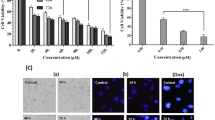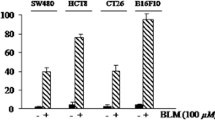Summary
The objective of the experiments reported in this paper was the identification of promising anthracycline analogs on the basis of lack of cross-resistance against tumor cells presenting either P-glycoprotein multidrug resistance (Pgp-MDR) or the altered topoisomerase multidrug resistant (at-MDR) phenotype.
Differently modified anthracycline analogs known to be active against MDR cells were assayedin vitro against CEM human leukemic cells, and the sublines CEM/VLB100 and CEM/VM-1 exhibiting respectively the Pgp-MDR and the at-MDR phenotype. Two classes of molecules, in which the -NH2 group in C-3′ position is substituted with a morpholino, methoxymorpholino (morpholinyl-anthracycline), or an alkylating moiety, present equivalent efficacy in the drug-sensitive and the two drug-resistant sublines. These results indicate that such molecules may exert their cytotoxic effect through a mode of action different from that of “classical” anthracyclines and is not mediated through topoisomerase II inhibition. Both molecules represent novel concepts in the field of new anthracyclines derivatives.
Similar content being viewed by others
References
Gottesman MM: How cancer cells evade chemotherapy: Cancer Res 53:747–754, 1993
Kaye SB: The multidrug resistance phenotype. Br J Cancer 58:691–694, 1988
van Kalken CK, Pinedo HM, Giaccone G: Multidrug resistance from the clinical point of view. Eur J Cancer 27:1481–1486, 1991
Beck WT: Unknowing the complexities of multidrug resistance: the involvement of DNA topoisomerases in drug action and resistance. JNCI 81:1683–1685, 1989
Cole SPC, Bhardwaj G, Gerlach JH, Mackie JE, Grant CE, Almquist KC, Stewart AJ, Kurz EU, Duncan AMV, Deeley RG: Overexpression of a transporter gene in a multidrug-resistant human lung cancer cell line. Science 258:1650–1654, 1992
Danks MK, Yalowich JC, Beck WT: Atypical multiple drug resistance in a human leukemic cell line selected for resistance to teniposide (VM-26). Cancer Res 47:1297–1301, 1987
Danks MK, Schmidt CA, Cirtain MCet al.: Altered catalytic activity of and DNA cleavage by DNA topoisomerase II from human leukemic cells selected for resistance to VM-26. Biochemistry 27:8861–8869, 1988
Grandi M, Pezzoni G, Ballinari D, Capolongo L, Suarato A, Bargiotti A, Faiardi D, Spreadfico F: Novel anthracycline analogs. Cancer Treat Rew 17:133–138, 1990
Facchetti I, Grandi M, Cucchi P, Geroni C, Penco S, Vigevani A: Influence of lipophilicity on cytotoxicity of anthracyclines in LoVo and LoVo/DX human cell lines. Anti-Cancer Drug Design 6:385–397, 1991
Acton EM, Tong GL, Mosher CW, Wolgemuth RL: Intensely potent morpholinyl anthracyclines. J Med Chem 27:638–645, 1984
Beck WT, Mueller TJ, Tanzer LR: Altered surface membrane glycoproteins inVinca alkaloid-resistant human leukemic lymphoblasts. Cancer Res 39:2070–2076, 1979
Ripamonti M, Pezzoni G, Pesenti E, Pastori A, Farao M, Bargiotti A, Suarato A, Spreafico F, Grandi M:In vivo anti-tumour activity of FCE 23762, a methoxymorpholinyl derivative of doxorubicin active on doxorubicin-resistant tumour cells. Br J Cancer 65:703–707, 1992
Acton EM, Tong GL, Taylor DL, Filppi JA, Wolgemuth RL: New cyanomorpholinyl byproduct of doxorubicin reductive alkylation. J Med Chem 29:1225–1230, 1986
Lau DHM, Lewis AD, Sikic BI: Association of DNA cross-linking with potentiation of the morpholino derivative of doxorubicin by human liver microsomes. JNCI 81:1034–1038, 1989
Lau DHM, Lewis AD, Duran GE, Sikic BI: The cellular and biochemical pharmacology of the methoxy morpholino derivative of doxorubicin, FCE 23762. Proc Am Assoc Cancer Res 32:332, abstr 1970, 1992
Geroni C, Pesenti E, Broggini M, Belvedere G, Tagliabue G, Dincalci M, Pennella G, Grandi M: L1210 cells selected for resistance to methoxymorpholinyl-doxorubicin appear specifically resistant to this class of morpholinyl derivatives. Br J Cancer 69:315–319, 1994
Author information
Authors and Affiliations
Rights and permissions
About this article
Cite this article
Mariani, M., Capolongo, L., Suarato, A. et al. Growth-inhibitory properties of novel anthracyclines in human leukemic cell lines expressing either Pgp-MDR or at-MDR. Invest New Drugs 12, 93–97 (1994). https://doi.org/10.1007/BF00874437
Issue Date:
DOI: https://doi.org/10.1007/BF00874437




